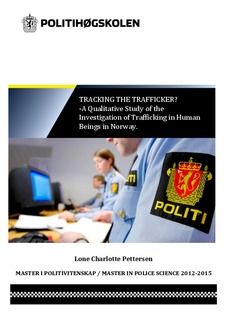| dc.description.abstract | Trafficking in human beings (THB) is a vast global problem where the cynic exploitation of fellow human beings is limited only by the exploiter’s creativity and cruelty. This paper looks upon the phenomena of THB from a law enforcement perspective, thus defining and problematizing it as a crime against humanity and a crime against international and national laws. Consequently, understanding the complexity of the crime enables the investigator and prosecutor to better conduct criminal investigations to uncover, prevent and prosecute the crime of THB.
Norway is a recipient country, and to some extent also a transit country, which means that the victims of THB in Norway are mostly from foreign countries. However, the numbers on THB are not reliable when it comes to describing the reality of victims that have yet to be identified by Norwegian authorities. Thus, the majority of THB-cases reported, investigated and receiving convictions, are THB for sexual exploitation. Trafficking for other types of exploitation is widely underreported. At the same time, research on the field of trafficking in Norway has focused mainly on sexual exploitation. However, this paper does not distinguish between the different types of exploitation. Rather, it focuses on how the police investigate the phenomena in order to be able to prosecute the traffickers.
As such, this paper is based on a qualitative study where police investigators and police prosecutors from 8 different police districts in Norway have been interviewed about their knowledge and experience in investigating cases of THB. The study aims to answer the following approach to the research topic: Tracking the Trafficker? A qualitative study of the investigation of trafficking in human beings in Norway.
The research findings suggest that there is a severe lack of competency in THB in general in the Norwegian police and that this affects the outcome of THB-‐cases in several ways. The police does not initiate THB-cases themselves, rather they are to a large extent recipients of information from others – especially the victim. This leads to a highly victim-‐oriented approach to the investigation, placing much responsibility on the victim to provide the investigation with sufficient information to identify the trafficker or other important part of the exploitation they have been exposed to. Furthermore, the victim itself is considered a great challenge in the investigation of THB‐cases. The findings also indicate that the organisational structure of the police districts, combined with how THB is prioritized with regard to resources and personnel, may have some affect as to how the investigation is conducted in the different police districts. | nb_NO |
